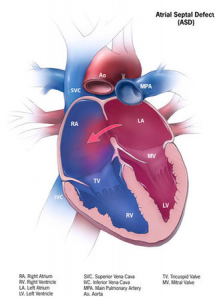
An Atrial Septal Defect (ASD) is a congenital heart defect where there is a hole between to two upper chambers of the heart. Blood passes through the hole from left to right and strains the right side of the heart from the excess blood flow. Over time this can lead to:
- Shortness of breath with exercise, and fatigue
- Right heart enlargement and heart failure
- Arrhythmias, irregular heart beats, such as atrial fibrillation
- Stroke/paradoxical embolization
- Tricuspid regurgitation
- Pulmonary hypertension- in time can become irreversible and lead to right-to-left shunting (Eisenmenger syndrome.)
Some ASDs close on their own in childhood; others are very small and do not cause problems. However, for larger defects treatment is often required and consisted of either cardiac catheterization or open heart surgery. A catheter is inserted into a blood vessel in the groin and is guided to the heart. Then a mesh plug/device closes the hole, and skin grows around the device to seal it. The procedure does not work on all types of ASDs. The other option is open heart surgery to patch or sew the hole closed. There is a better long-term outcome if surgery is done before age 25.
In regards to the prevalence rate, ASD is the most frequently encountered major congenital cardiac disorder in the adult population, with a prevalence of 0.2 to 0.7 per thousand.
Links
- Adult Congenital Heart Association- ASD
- Cleveland Clinic- ASD
- Canadian Adult Congenital Heart Network- ASD
- Mayo Clinic- ASD
- Cove Point Foundation- ASD
- NIH Holes in the Heart
- National Organization of Rare Disorders- ASD click anywhere on the page to get rid of the pop-up
- Circulation- ASDs in Adults
- Cleveland Clinic- How is an ASD Closed Using a Catheter-Based Approach
- NIH- Open Heart Surgery
References
American Heart Association. (2016). Increasing number of U.S. adults living with congenital heart defects. Retrieved from https://newsroom.heart.org/news/increasing-number-of-u-s-adults-living-with-congenital-heart-defects
Connolly, H. M. (2017). Surgical and percutaneous closure of atrial septal defects in adults. In S. B. Yeon (Ed.), UpToDate. Retrieved February 4, 2018, from https://www.uptodate.com/contents/screening-for-depression-in-adults
Konstantinides, S., Geibel, A., Kasper, W., & Just, H. (1991). The natural course of atrial septal defect in adults–a still unsettled issue. Klin Wochenschr, 69(12), 506-10.
Kuijpers, J. M., Mulder, B. J. M., & Bouma, B. J. (2015). Secundum atrial septal defect in adults: a practical review and recent developments. Netherlands Heart Journal, 23(4), 205–211.
Mayo Clinic. (2018). Atrial septal defect (ASD). Retrieved from https://www.mayoclinic.org/diseases-conditions/atrial-septal-defect/symptoms-causes/syc-20369715
Shuler, C.O., Tripathi A, Black, G. B., Park, Y. M., & Jerrell, J. M. (2013). Prevalence of treatment, risk factors, and management of atrial septal defects in a pediatric Medicaid cohort. Pediatr Cardiol, 34(7), 1723-8. doi: 10.1007/s00246-013-0705-5